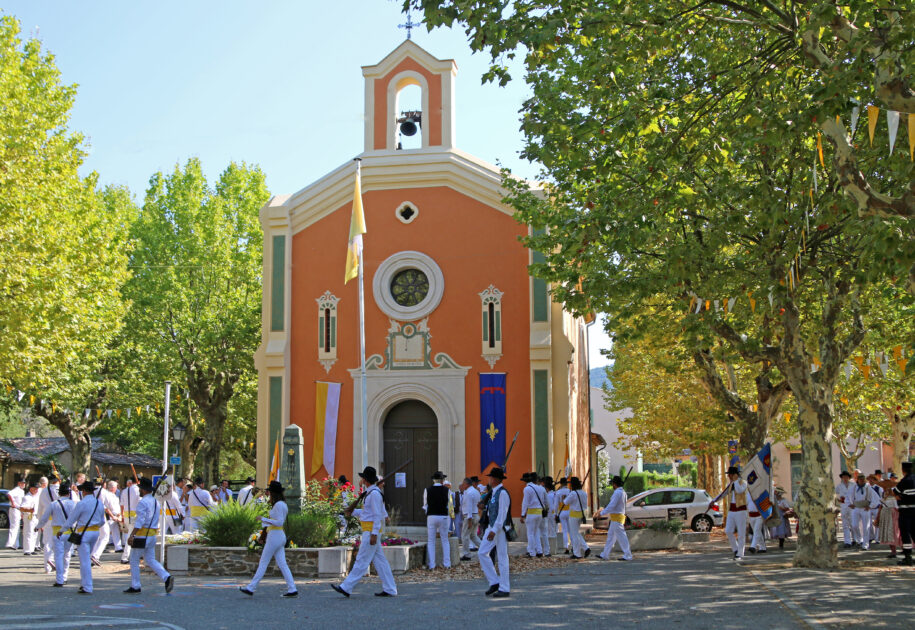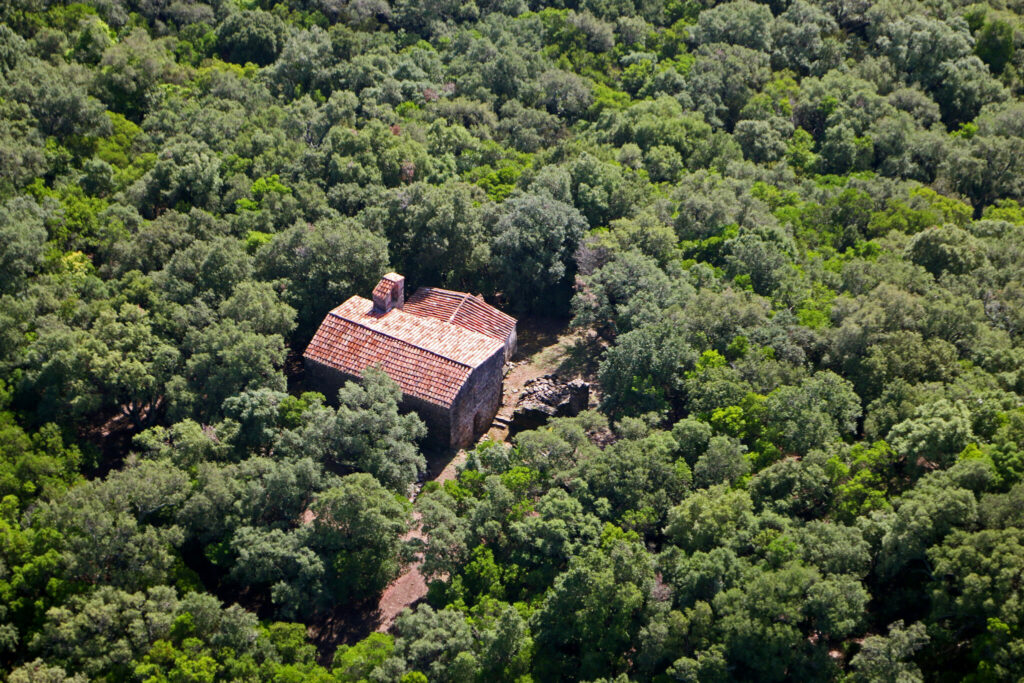Home Explore The villages of the Gulf to discover
La Mole
Welcome to a happy valley
On the edge of the Dom forest, the valley of La Mole offers an unspoilt natural setting, where time seems to stand still. The village, a starting point for many contemplative walks, nevertheless hides many secrets just waiting to be revealed…
AN IDENTITY WORTH PRESERVING

La Mole embodies the tranquillity of a small Provencal village nestling in the heart of nature, and it passionately defends its autonomy. Indeed, although La Mole is the south-western gateway to the Gulf of Saint-Tropez, it proudly claims to belong to the Massif des Maures! An aerial view of the village, surrounded by exceptional greenery, confirms this claim. At the heart of the village is the motto engraved beneath the sundial of its charming church: “Souviens-toi de vivre” (“Remember to live”). The original village, with its renowned tables, has seen its population triple in recent years, but it’s now big enough! No one will encroach on the forest track that leads to the discreet chapel of Sainte-Magdeleine. Nothing should disturb the course of the river as it meanders through vineyards and reeds: nature remains sovereign and its best produce awaits you at the Sunday market.
AN UNFORGETTABLE PANORAMA OVER A SEA OF GREEN
At the other end of the village is a remarkable château, which is proud to have been the childhood home of Antoine de Saint-Exupéry, author of the famous book The Little Prince, who described the place vividly. Directly opposite the château is the airport runway, interrupted by a stream that gives the village its name. If you follow the bridge over this stream, you will come to a small road that crosses a marvellous plain, where goats and sheep move about during the transhumance. This road takes you as far as the Pachacaïd accommodation complex, before winding its way up, bend after bend, to the Col du Canadel. From the summit, you’ll be able to enjoy an exceptional view of the sea, but we won’t neglect the beauty of the adjacent valley. You’ll be able to admire the renowned vineyards that line the cross-roads or follow the paths up to the surrounding peaks. You’ll also be enchanted by the wild streams, the smell of humus, mushrooms and eucalyptus in the surrounding forests, and the presence of free-roaming horses. And in the distance, you’ll catch a glimpse of a silver-blue speck in this vast expanse of green…

FROM THE VERNE DAM TO THE SILENCE OF THE CHARTREUSE
This oasis nestling in the Maures mountains is the Verne dam, built in 1991 to a height of 42 metres and a crest 235 metres long. This vast body of water, fed by the Verne, a tributary of the River la Mole, is home to families of grey herons and cormorants. In autumn, it becomes a refuge for migratory birds, while in spring, water turtles bask in the impromptu waterfalls, under the amused gaze of wild boars and foxes that have come to drink. It’s almost like being in the Alps. Yet it is this site that supplies fresh water to the saltwater communities of the Gulf, just a few leagues from here. Although swimming and boating are forbidden, the path along the left bank will take hardened hikers or experienced cyclists to the Chartreuse de la Verne, an impressive monastery founded in 1170 and listed as a historic monument. It has been magnificently restored by enthusiasts of the site. This timeless place is inhabited by around fifteen cloistered nuns who observe the rule of silence. Yes, there are still many secrets to be discovered in La Mole.
LET’S GO FOR A WALK
From Place de l’Eglise, take the road towards Toulon. After 800 metres at the traffic lights, turn right towards “Usine des Eaux”, where you can leave your car. To get to the dam, we recommend that you wear suitable footwear or, if you prefer, take your mountain bike. A wide dirt track will take you 2.5 km further to the dam entrance gate, 150 m before you reach the dam. You can either walk across the dam or along its edge. If you’re a good walker, take the path that starts off to the left at the flags; the track that runs alongside the dam is really superb, and it takes at least 2? hours to reach the Chartreuse de la Verne. Please allow time for the return journey.
A LITTLE BIT OF HISTORY
La Mole area was first mentioned in 1008, in a charter in the cartulary of the Benedictine abbey of Saint-Victor de Marseille. The medieval village of Sainte-Madeleine was located to the west of the Maravieille plateau on a basalt outcrop. From the end of the 12th century, part of the territory of La Mole was part of the domain of the Carthusian monks of La Verne, an abbey founded in 1170. The area was deserted by the end of the 14th century. A few centuries later, an attempt to repopulate the area failed and it remained uninhabited until the 19th century. In 1770, the seigneury of La Mole was acquired by Emmanuel de Boyer de Fonscolombe, knight and adviser to the King at the Court of the Parliament of Provence, from Joseph-Jean-Baptiste de Suffren, Marquis of Saint-Tropez, the brother of the famous Bailiff. The present-day village was built in the 19th century.
NOT TO BE MISSED
• La Mole parish chapel (19th century) in the village centre.
• Sainte-Magdeleine Church (11th century) up on the hill: the castra and chapel are listed regional heritage sites.
• The Château (1km, direction Cogolin), a private estate visible from the road.
• La Mole Chapel (private) opposite the airport.
• International airport of the Gulf of Saint-Tropez (business aviation, summer routes and events).
• The Provencal market from April to October.
PANORAMAS
• The Verne dam and road up to the monastery.
• Col du Canadel (267m) and the winding road up to a stunning view of Cavalaire bay and the Îles d’Or, above Rayol-Canadel. • Les Pradels (on foot – 528m) for a panorama of the coast and the Maures coastal road with orientation table.
INFORMATION
Tourist Office
Catégorie 2 – Open from mid-April to the end of September
Médiathèque – 2 Rue du Clocher
83310 La Mole
+33 (0)4 94 49 66 64 – lamole@golfe-sainttropez-tourisme.fr
Tourist Office website: www.golfe-sainttropez-tourisme.fr
Destination website: www.visitgolfe.com
Copyright: Office de tourisme communautaire Golfe de Saint-Tropez Tourisme
3 results





